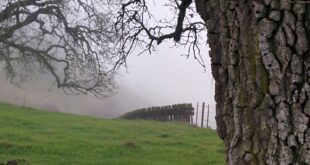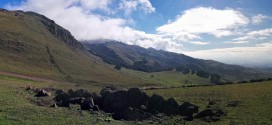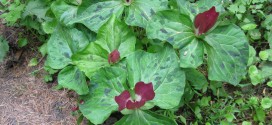In 1850, the Martin Murphy Jr family had a 20-room house in what is now Sunnyvale. Because there were no lumber mills at that time, Murphy ordered the home to be built in Bangor, Maine; disassembled; shipped around Cape Horn; and reassembled. Because there were also no suppliers of nails, man named Dawson managed to put the house together using wooden pegs and rawhide ties for a cost of 500 acres. This was one year after the 1849 Gold Rush. There was an acute labor shortage at that time as many men left to search for gold. When ships would arrive in San Francisco, the crews would often abandon the ship and head for the gold fields. There were hundreds of ships abandoned in the bay.
The Murphys were not the only ones importing houses. Also in 1850 Peleg Rush imported twenty-three houses from Boston and set them up in Santa Clara.
The Martin Murphy party crossed the plains in 1844 to California. They were the first party to cross the Sierras in a covered wagon, the first to bring oxen across the plains and the first to use the route now used by Union and Pacific Railroads. The Donner party used the route two years later and Martin Murphy, Jr. was a member of the party who rescued them.
The Murphy house was the site of the largest private party ever held in California. It was held in July of 1881, which was the 50th wedding anniversary of Murphy’s. General invitations were sent out and it is estimated that over 10,000 people came. Special trains came from San Francisco and San Jose for it. The party lasted three days. Wood from the 1000 square foot dance floor constructed for the celebration was later donated to the priests for the first Mountain View Chapel there.
Rancho Posolmi y Posita de Las Animas, a 1,696 acre land grant was made to the Indian Lupe (or Lopez) Ynigo on February 15, 1844. Another 8,800 acres of former Mission Santa Clara sheep pasturage were granted in 1842 to Francisco and Inez (Castro) Estrada. Their Rancho Pastoria de Los Borregas today is encompassed by the cities of Sunnyvale and Mountain View. It had formerly been used as pasture land by the Mission Santa Clara. Through a series of circumstances, the land was passed to Inez’ father, Mariano Castro, the former Alcade (mayor) of San Jose. He occupied the Rancho in 1843, where he raised cattle, horses, sheep and a few crops.
In 1850, Murphy purchased one half of the Pastoria de las Borregas, a total of 4,800 acres (7.5 square miles) for approximately $1 per acre. It was the Murphy property that was destined to become Sunnyvale. This purchase cost $4800 dollars in gold. The extended Murphy family had done extraordinarily well since arriving 6 years earlier with a couple of wagons and oxen. it is unclear what portion of their wealth came from finding gold and what portion came from selling wheat, cattle, and horses.
The Murphy’s played a very important part in early California history. Martin Murphy, Jr. is credited with founding Sunnyvale, bringing the railroad through his property and helping to establish the Convent of Notre Dame and Santa Clara College. These were the first institutions of higher learning in the area. His son was the first student enrolled and is the only layman interred in the Mission Chapel. The Murphy family were Irish and Catholic and proud of both.
The Murphy family is credited with founding four other cities in the area. Martin Murphy Sr. started San Martin, Martin Murphy Jr. started Sunnyvale and son John the town of Murphys in gold country. Sons John and Daniel struck gold in the Sierras, then made a fortune selling dry goods to local miners and Native Americans. Helen Murphy, the youngest daughter of Martin Sr., married Charles Maria Weber, the founder of the city of Stockton.Martin’s son James was the first bank commissioner, other family members were State assembly and Senate members, and Martin was the first rancher to grow wheat in the Sacramento Valley. Martin’s original ranch in the valley was the site of the Alvarez-Castro insurrection. His sons John and Patrick were officers in the Mexican War.
The original house was demolished in 1961. A replica is in the Sunnyvale Heritage Orchard.








